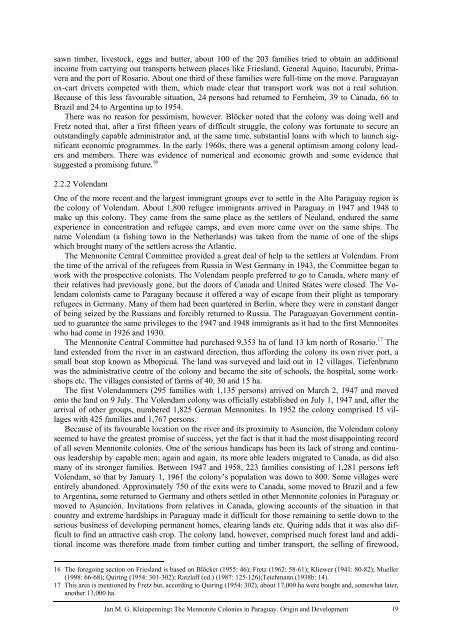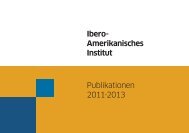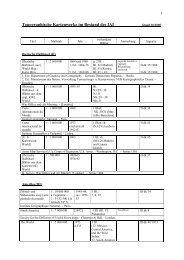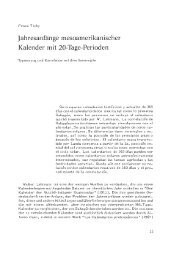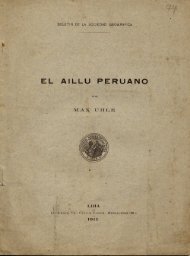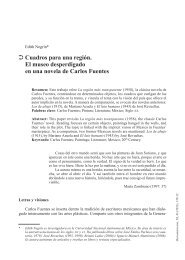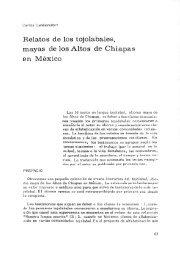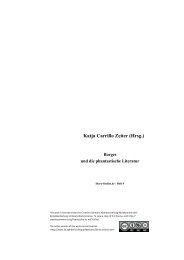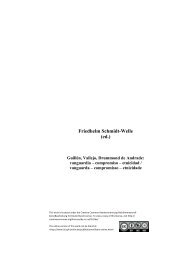The Mennonite Colonies in Paraguay. Origin - Ibero-Amerikanisches ...
The Mennonite Colonies in Paraguay. Origin - Ibero-Amerikanisches ...
The Mennonite Colonies in Paraguay. Origin - Ibero-Amerikanisches ...
Create successful ePaper yourself
Turn your PDF publications into a flip-book with our unique Google optimized e-Paper software.
sawn timber, livestock, eggs and butter, about 100 of the 203 families tried to obta<strong>in</strong> an additional<br />
<strong>in</strong>come from carry<strong>in</strong>g out transports between places like Friesland, General Aqu<strong>in</strong>o, Itacurubí, Primavera<br />
and the port of Rosario. About one third of these families were full-time on the move. <strong>Paraguay</strong>an<br />
ox-cart drivers competed with them, which made clear that transport work was not a real solution.<br />
Because of this less favourable situation, 24 persons had returned to Fernheim, 39 to Canada, 66 to<br />
Brazil and 24 to Argent<strong>in</strong>a up to 1954.<br />
<strong>The</strong>re was no reason for pessimism, however. Blöcker noted that the colony was do<strong>in</strong>g well and<br />
Fretz noted that, after a first fifteen years of difficult struggle, the colony was fortunate to secure an<br />
outstand<strong>in</strong>gly capable adm<strong>in</strong>istrator and, at the same time, substantial loans with which to launch significant<br />
economic programmes. In the early 1960s, there was a general optimism among colony leaders<br />
and members. <strong>The</strong>re was evidence of numerical and economic growth and some evidence that<br />
suggested a promis<strong>in</strong>g future. 16<br />
2.2.2 Volendam<br />
One of the more recent and the largest immigrant groups ever to settle <strong>in</strong> the Alto <strong>Paraguay</strong> region is<br />
the colony of Volendam. About 1,800 refugee immigrants arrived <strong>in</strong> <strong>Paraguay</strong> <strong>in</strong> 1947 and 1948 to<br />
make up this colony. <strong>The</strong>y came from the same place as the settlers of Neuland, endured the same<br />
experience <strong>in</strong> concentration and refugee camps, and even more came over on the same ships. <strong>The</strong><br />
name Volendam (a fish<strong>in</strong>g town <strong>in</strong> the Netherlands) was taken from the name of one of the ships<br />
which brought many of the settlers across the Atlantic.<br />
<strong>The</strong> <strong>Mennonite</strong> Central Committee provided a great deal of help to the settlers at Volendam. From<br />
the time of the arrival of the refugees from Russia <strong>in</strong> West Germany <strong>in</strong> 1943, the Committee began to<br />
work with the prospective colonists. <strong>The</strong> Volendam people preferred to go to Canada, where many of<br />
their relatives had previously gone, but the doors of Canada and United States were closed. <strong>The</strong> Volendam<br />
colonists came to <strong>Paraguay</strong> because it offered a way of escape from their plight as temporary<br />
refugees <strong>in</strong> Germany. Many of them had been quartered <strong>in</strong> Berl<strong>in</strong>, where they were <strong>in</strong> constant danger<br />
of be<strong>in</strong>g seized by the Russians and forcibly returned to Russia. <strong>The</strong> <strong>Paraguay</strong>an Government cont<strong>in</strong>ued<br />
to guarantee the same privileges to the 1947 and 1948 immigrants as it had to the first <strong>Mennonite</strong>s<br />
who had come <strong>in</strong> 1926 and 1930.<br />
<strong>The</strong> <strong>Mennonite</strong> Central Committee had purchased 9,353 ha of land 13 km north of Rosario. 17 <strong>The</strong><br />
land extended from the river <strong>in</strong> an eastward direction, thus afford<strong>in</strong>g the colony its own river port, a<br />
small boat stop known as Mbopicuá. <strong>The</strong> land was surveyed and laid out <strong>in</strong> 12 villages. Tiefenbrunn<br />
was the adm<strong>in</strong>istrative centre of the colony and became the site of schools, the hospital, some workshops<br />
etc. <strong>The</strong> villages consisted of farms of 40, 30 and 15 ha.<br />
<strong>The</strong> first Volendammers (295 families with 1,135 persons) arrived on March 2, 1947 and moved<br />
onto the land on 9 July. <strong>The</strong> Volendam colony was officially established on July 1, 1947 and, after the<br />
arrival of other groups, numbered 1,825 German <strong>Mennonite</strong>s. In 1952 the colony comprised 15 villages<br />
with 425 families and 1,767 persons.<br />
Because of its favourable location on the river and its proximity to Asunción, the Volendam colony<br />
seemed to have the greatest promise of success, yet the fact is that it had the most disappo<strong>in</strong>t<strong>in</strong>g record<br />
of all seven <strong>Mennonite</strong> colonies. One of the serious handicaps has been its lack of strong and cont<strong>in</strong>uous<br />
leadership by capable men; aga<strong>in</strong> and aga<strong>in</strong>, its more able leaders migrated to Canada, as did also<br />
many of its stronger families. Between 1947 and 1958, 223 families consist<strong>in</strong>g of 1,281 persons left<br />
Volendam, so that by January 1, 1961 the colony’s population was down to 800. Some villages were<br />
entirely abandoned. Approximately 750 of the exits were to Canada, some moved to Brazil and a few<br />
to Argent<strong>in</strong>a, some returned to Germany and others settled <strong>in</strong> other <strong>Mennonite</strong> colonies <strong>in</strong> <strong>Paraguay</strong> or<br />
moved to Asunción. Invitations from relatives <strong>in</strong> Canada, glow<strong>in</strong>g accounts of the situation <strong>in</strong> that<br />
country and extreme hardships <strong>in</strong> <strong>Paraguay</strong> made it difficult for those rema<strong>in</strong><strong>in</strong>g to settle down to the<br />
serious bus<strong>in</strong>ess of develop<strong>in</strong>g permanent homes, clear<strong>in</strong>g lands etc. Quir<strong>in</strong>g adds that it was also difficult<br />
to f<strong>in</strong>d an attractive cash crop. <strong>The</strong> colony land, however, comprised much forest land and additional<br />
<strong>in</strong>come was therefore made from timber cutt<strong>in</strong>g and timber transport, the sell<strong>in</strong>g of firewood,<br />
16 <strong>The</strong> forego<strong>in</strong>g section on Friesland is based on Blöcker (1955: 46); Fretz (1962: 58-61); Kliewer (1941: 80-82); Mueller<br />
(1998: 66-68); Quir<strong>in</strong>g (1954: 301-302); Ratzlaff (ed.) (1987: 125-126);Teichmann (1938b: 14).<br />
17 This area is mentioned by Fretz but, accord<strong>in</strong>g to Quir<strong>in</strong>g (1954: 302), about 17,000 ha were bought and, somewhat later,<br />
another 13,000 ha.<br />
Jan M. G. Kle<strong>in</strong>penn<strong>in</strong>g: <strong>The</strong> <strong>Mennonite</strong> <strong>Colonies</strong> <strong>in</strong> <strong>Paraguay</strong>. Orig<strong>in</strong> and Development<br />
19


